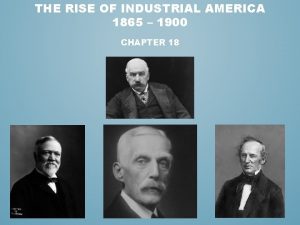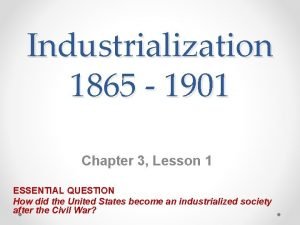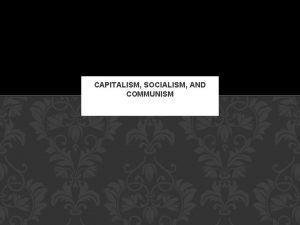The Rise of Industry LaissezFaire Capitalism 1865 1900







- Slides: 7

The Rise of Industry Laissez-Faire Capitalism 1865 -1900

The Growth of Railroads n n Eastern rails were consolidated in the early part of the 19 th Century. The western rails were constructed in concert with the expansion of the frontier. The federal government promoted the growth of rails through land grants. Railroads received 170 million acres of public land These led to widespread corruption including the Credit Mobilier scandal Railroads occasionally owned up to half of all land in the Western states

Industrial Empires n n Financier J. P. Morgan helped to consolidate the railroads during the Panic of 1893 He bought up a significant portion of the 1/4 th of all rails that went bankrupt The steel industry was consolidated by Andrew Carnegie; US Steel became the world’s first billion dollar corporation The oil industry was consolidated by John Rockefeller in the Standard Oil Trust

The Rise of Laissez-Faire n n n Laissez Faire capitalism advocated for a hands off approach to regulating business Social Darwinism was thought to rule the world of business, those most able would rise to the top Another attempt to justify consolidation was the Gospel of Wealth. This said that wealth was the clearest sign of God’s favor for your hard work

Impact of Industrialization Concentration of Wealth: n A few industrialists became fabulously wealthy n The Horatio Alger Myth portrayed hard working young individuals that made it rich through diligence. This was just a myth. The expanding middle class: n Corporations created the need for salaried, white-collar workers as well, these individuals increased the demand for basic services Working women: n 1 in 5 adult women were in the workforce in 1900

The Struggle of Organized Labor n Industry used many tactics to squelch organized labor including q n Lockouts, Blacklists, Yellow-dog contracts and Court injunctions Organized labor rose in the post Civil War period q q National Labor Union- the first attempt to organize all workers it was gone by 1877 Knights of Labor- organized in secret in 1869, they went public in 1881. Open to women and blacks American Federation of Labor- Samuel Gompers led this union of skilled workers Labor unrest of the time included the Haymarket Bombing, the Great Railroad Strike, the Homestead Strike and the Pullman Strike

The Haymarket Bombing













